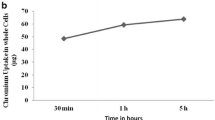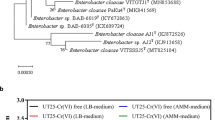Abstract
Two bacterial consortia were developed by continuous enrichment of microbial population of tannery and pulp and paper mill effluent contained Serratia mercascens, Pseudomonas fluorescence, Escherichia coli, Pseudomonas aeruginosa and Acinetobacter sp. identified by 16S rDNA method. The consortia evaluated for removal of chromate [(Cr(VI)] in shake flask culture indicated pulp and paper mill consortium had more potential for removal of chromate. Acinetobacter sp. isolated from pulp and paper mill consortium removed higher amount of chromate [Cr(VI)] under aerobic conditions. Parameters optimized in different carbon, nitrogen sources, and pH, indicated maximum removal of chromate in sodium acetate (0.2%), sodium nitrate (0.1%) and pH 7 by Acinetobacter sp. Bacteria was applied in 2-l bioreactor significantly removed chromate after 3 days. The results of the study indicated removal of more than 75% chromium by Acinetobacter sp. determined by diphenylcarbazide colorimetric assay and atomic absorption spectrophotometer after 7 days. Study of microbial [Cr(VI)] removal and identification of reduction intermediates has been hindered by the lack of analytical techniques. Therefore, removal of chromium was further substantiated by transmission electron microscopy (TEM), scanning electron microscopy (SEM) and energy-dispersive X-ray spectroscopy (EDX) which indicated bioaccumulation of chromium in the bacterial cells.






Similar content being viewed by others
References
Ackerley DF, Gonzalez CF, Park CH, Blake IIR, Keyhan M Matin A (2004) Chromate reducing properties of soluble flavoproteins from Pseudomonas putida and Escherchia coli. Appl Environ Microbiol 70 (2):873–882
Baldi F, Vaughan AM, Olson GJ (1990) Chromium (VI) resistant yeast isolated from a sewage treatment plant receiving tannery wastes. Appl Environ Microbiol 56:913–918
Beveridge TJ (1988) The bacterial surface: general considerations towards design and function. Can J Microbiol 34:363–372
Beveridge TJ, Murray RG (1976) Uptake and retention of metals by cell wall of Bacillus subtillis. J Bacteriol 127:1502–1518
Blake RC, Choate HDM, Bardhman B, Revis N, Barton LL, Zocco TG (1993) Chemical transformation of toxic metals by a Pseudomonas strain from a toxic waste site. Environ Toxicol Chem 12:1365–1376
David GFX, Herbert J, Wright CDS (1973) The ultrastructure of the pineal ganglion in the ferret. J Anat 115:79–97
De Leo PC, Ehrlich HL (1994) Reduction of hexavalent chromium by Pseudomonas fluorescens LB300 in batch and continuous cultures. Appl Microbiol Biotech 40:756–759
Garcia-Arellano H, Alcalde M, Ballesteros A (2004) Use and improvement of microbial redox enzymes for environmental purposes .Microbial Cell Fact 3:10–14
Gonzalez CF, Ackerley DF, Lynch SV, Matin A (2005) ChrR, a soluble quinine reductase of Pseudomonas putida that defends against H2O2. J Biol Chem 17:280–285
Greenberg AE, Connors JJ, Jenkins D, Franson MA (1995) Standard methods for the examination of water and waste water, 14th ed. American public health association, Washington, DC
Kapoor A, Virararaghavan T (1995) Fungal biosorption an alternative treatment option of heavy metal bearing waster water. Biores Technol 53:195–206
Leusch A, Holan ZR, Volesky B (1995) Biosorption of heavy metals (Cd,Cu,Ni,Pb,Zn) by chemically reinforced biomass of marine algae. J Chem Technol Biotechnol 62:279–288
McLean J, Beveridge TJ (2001) Chromate reduction by a Pseudomond isolated from a site contaminated with chromate copper arsenate. Appl Env Microbiol 67 (3):1076–1084
Moore ERB, Wittich RM, Fortnagel P, Timmis KN (1993) 16S ribosomal RNA gene sequence characterization and phylogenetic analysis of a dibenzo-p-dioxin-dagrading isolate within the new genus Sphingomonas. Lett Appl Microbiol 17:115–118
Mullen LD, Wolfe DC, Ferris FG, Beveridge TJ, Flemming CA, Bailey GW (1989) Bacterial sorption of heavy metal. Appl Environ Microbiol 55:3143–3149
Park CH, Keyhan M, Wielinga B, Fendorf S, Matin M (2000) Purification to homogeneity and characterization of a novel Pseudomonas putida chromate reductase. Appl Environ Microbiol 66:1788–1795
Pellerin C, Booker SM (2000) Reflections on hexavalent chromium. Environ Health Persp. 108:402–407
Pfenning N, Lippert KD (1966) Uper das vitamin B-12 Bedurfins phototropher Schwefelbakterien. Arch Microbiol 55:245–256
Shrivastava S, Thakur IS (2003) Bioabsortion potentiality of Acinetobacter sp. strain IST103 of a bacterial consortium for removal of chromium from tannery effluent. J Sc Ind Res 62:616–622
Srivastava S, Thakur IS (2006) Isolation and process parameter optimization of Aspergillus sp. for removal of chromium from tannery effluent. Biores Technol 97:1167–1173
Srivastava S, Ahmad AH, Thakur IS (2007) Removal of chromium and pentachlorophenol from tannery effluents. Biores Technol 98:1128–1132
Thakur IS (1995) Structural and functional characterization of a stable, 4-chlorosalicylic-acid-degrading bacterial community in a chemostat. World J Microbiol Biotechnol 11:643–645
Volesky B, Holan ZR (1995) Biosorption of heavy metals. Biotechnol Prog 11:235–250
Acknowledgement
We would like to thank Department of Biotechnology, Government of India, New Delhi, for providing funding. We like to thanks Birbal Sahani Institute of Paleobotany, Lucknow, India, for providing facilities for SEM–EDX, and All India Institute of Medical Sciences, New Delhi, India, TEM facility.
Author information
Authors and Affiliations
Corresponding author
Rights and permissions
About this article
Cite this article
Srivastava, S., Thakur, I.S. Evaluation of biosorption potency of Acinetobacter sp. for removal of hexavalent chromium from tannery effluent. Biodegradation 18, 637–646 (2007). https://doi.org/10.1007/s10532-006-9096-0
Received:
Accepted:
Published:
Issue Date:
DOI: https://doi.org/10.1007/s10532-006-9096-0




